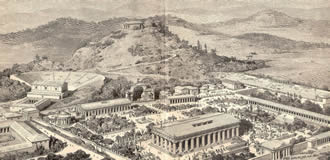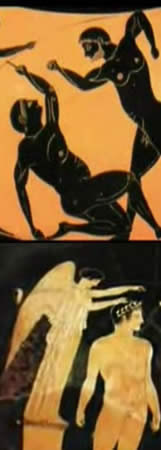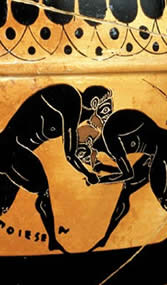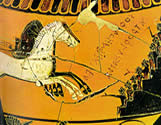
















Ancient olympia history


>>
Olympics


Day 1 of the Ancient Olympics
In the morning, athletic competitors and their trainers went to the vouleutirion, or council building in Olympia. Ten Hellanodikai (Olympic Judges) and organizers with the olympic Oath.
Next the competitors would proceed to the Altis a sacred olive-grove and go to one of the many alters. The men would make offerings to a god Zeus, Hermes, Apollo, or Hercules. They would pray for victory.
Then only competitions on the first day were running, wrestling and boxing for boys.
The afternoon was free for contestnts to explore Olympia Especially exciting was the Temple of Zeus with the famous statue of Zeus, considered of the seven wonders of the Ancient World.
Day 2 of the Ancient Olympics
Day two began with a procession of horses, riders and chariots into the hippodrome, or horse racing arena. This day was the day of chariot and horse rases. The chariot races were one of the most exciting and dangerous events of the games. There were both four-horse chariot and two-horse chariot races with distances ranging from 2,5 miles up to 8 miles. Horse races were just after the chariot rases and were often much shorter in length.
In the afternoon the competitions moved to the stadium for the pentathlon, which incluted five events: running wrestling, long jump, discus and javelin. The first athlete to win tree events was crowned the victor.
At the end of the day crowns gathered at the shrine of the hero Pelops, winner of the first chariot race. Funeral ceremonies were reenacted around the Altis and specially written hymns were sung in honor of victors. The day ended with feasts and celebrations.
Day 3 of the Ancient Olympics
The most important religious event of the whole Olympic festival started on the day tree of the Games -and was the sacrifice to Zeus. All gathered at the entrance to the Altis. Ambassadors from the Greek states brought symbols of their cities to be shared at this celebrations. The Hellanodikai arrived and the procession began around the Altis passing the Temple of Hera, the tomb the hero Pelops, the Temple of Rhea (mother of Zeus) and the treasure houses of Greek states around the Mediterranean. The procession concluded at the Temple of Zeus, where priests made animal sacrifices.
In the afternoon runners ran a long race called the dolichos, whitch ranged in lenght from 2,25 miles to 2,75 miles. Next came the sprints or stades which were arount 630 feet in distance. The sprints finished at the western end of the stadium, were competitors would be facing the Altis.
In the evening, a great public banqued was held where athletes brought their families and other guests. They feasted on meat and enjoyed the lavish foods the Greek city representatives had brought.
Day 4 of the Ancient Olympics
The fourth day of competition was mainly for contact sports. The first sport of the day was whrestling. The were no rounds and whrestlers employed a variety of holds, lifts and other movements to make their opponents fall. Three falls and the man falling was declared the loser. In Greek myths, heroes were often especially good at whrestling. At midday, boxing began Boxers were often severely hurt, cut and disfigured and in extreme cases even killed. Boxers often went for their opponents head and face so fast footwork was essential for the competitors to avoid too many punches.
The final combat event of the day was the pagration, meaning "all-strength" in Greek. This sport compined boxing and wrestling. The goal for the athletes was to make their opponent give up and concede defeat.
The last event of this day was the hoplitodromos or race in armor. The race servend as a reminder that one purpose of athletics was prepare men to fight in battle. Competitors carried shields and wore helmets as they ran two lengths of the stadium.
Day 5 of the Ancient Olympics
Day five was the final day of the Olympics. This day was a day to celebrate the accomplishements of the victors. Spectators, trainers and athletes made their way, procession style, to Temple of Zeus for the final time, with the winners leading the way.
Before the festival a boy was chosen to cut a leafy branch from the ancient wild olive tree sacred to Zeus. The leaves were then woven into wreaths. When the procession reached the front of the temple, the winners would come forward and the Hellanodikai placed a wreath on the head of each winner.
The reast of the day and evening was spent feasting. There was a big public banquet as well as many private parties. The parties often lasted ate into the night.
Role of woman in the Ancient Olympic Games
Woman were not technically allowed to compete in the Olympic Games. However, woman could be declared winners in equestrian events as owners of the horses or the chariots. Kyniska a daughter of king of Sparta, won great fame as the first woman to train horses that won in the Games.
Married women were not allowed access to the stadium during the games. Only the priestess of Demeter was permitted to watch the games seated by the altar in the stadium.
Women had their own special competition known as the Heraia. The competition honored the goddess Hera and took place in the non-Olympiad years. The officials organizers and athletes were unmarried womans.
The Heraia was made up of tree sprint races along the stadium track, specially reduced in length by one-sixth. The competitors were divided into age groups, beginning with the youngest women. The winners were crowned with garlands of olive leaves and given a share of a cow sacrificed to Hera.
Olympic Truce
Truce bearers from the state of Elis traveled to all participating Greek cities states taking part in the games in order to announce the terms of the truce.
Each athlete had to take an oath that he had trained for ten months prior to the games. Thirty days prior to the olympic games athletes were required to gather at Elis for preliminary traing and trials. This was to make sure that all athletes were fit and received equal treatment. It was also to determine which athletes would participate in the official Games.





